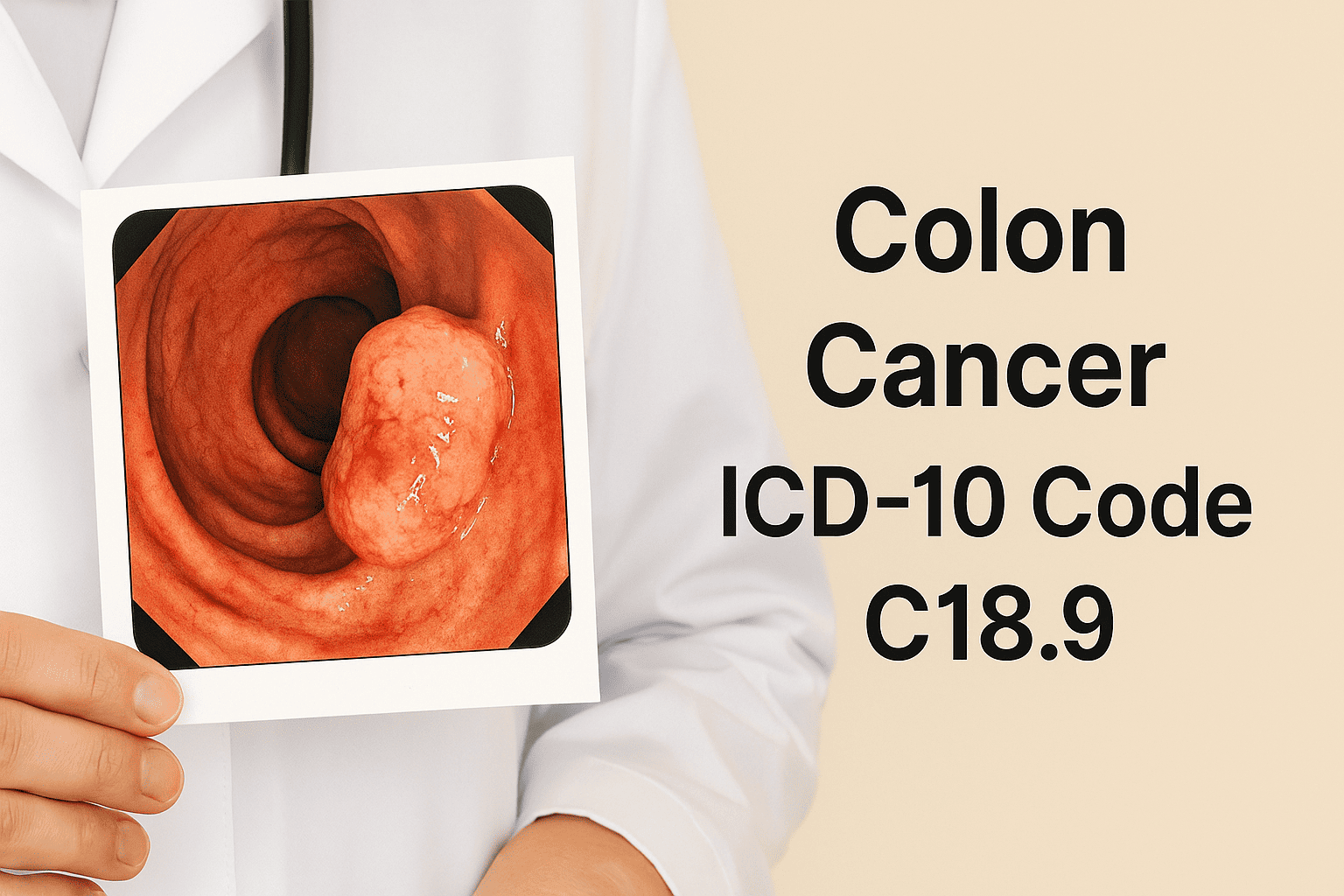Updated on: July 23, 2025
Colon cancer, or colorectal carcinoma, is one of the most prevalent malignancies globally. The ICD-10 code C18.9 is used when malignancy is diagnosed in the colon, but the exact anatomical site (ascending, transverse, descending, etc.) is not documented or known.
This code is often used during:
-
Initial diagnosis before imaging/pathology confirmation
-
Cases where documentation lacks tumor location
-
Outpatient visits or screenings awaiting follow-up
Breakdown of ICD-10 Code C18.9
-
C18 → Malignant neoplasm of colon
-
.9 → Unspecified site in the colon
🔍 Tip: Always update to a more specific subcode (e.g., C18.2 for ascending colon) once location is confirmed through imaging or biopsy.
Specific Colon Cancer Codes for Reference
| ICD-10 Code | Colon Region |
|---|---|
| C18.0 | Cecum |
| C18.2 | Ascending colon |
| C18.4 | Transverse colon |
| C18.6 | Descending colon |
| C18.7 | Sigmoid colon |
| C18.9 | Colon, unspecified |
When to Use C18.9
Use C18.9 only when:
-
A malignant tumor is confirmed in the colon
-
Site-specific documentation is absent
-
You’re awaiting final radiology/pathology reports
-
The patient has non-specific or widespread colonic involvement
Example Use Case:
“Patient diagnosed with adenocarcinoma following colonoscopy. Biopsy confirms malignancy. Tumor site yet to be specified on imaging. Coding assigned: C18.9.”
Key Documentation Points for C18.9
To support C18.9 coding, clinical notes should include:
-
Pathology confirmation of malignancy
-
Location stated only as “colon” (no quadrant or segment mentioned)
-
Symptoms (e.g., rectal bleeding, change in bowel habits, weight loss)
-
Plan for further imaging or surgical evaluation
Good Documentation Example:
“Biopsy-proven adenocarcinoma found on colonoscopy. Mass noted in the colon without clear demarcation of anatomical segment. CT scan pending. Plan to refer for surgical staging.”
Common Co-coded Conditions with C18.9
| Secondary Diagnosis | ICD-10 Code |
|---|---|
| Anemia due to malignancy | D63.0 |
| Weight loss | R63.4 |
| Intestinal obstruction | K56.69 |
| Personal history of colon cancer | Z85.038 |
| Encounter for chemotherapy | Z51.11 |
| Positive family history | Z80.0 |
Diagnostic and Treatment Workflow
When coding C18.9, providers often follow this workflow:
-
Clinical symptoms: Rectal bleeding, fatigue, change in stool frequency
-
Diagnostic tools: Colonoscopy with biopsy, CT abdomen/pelvis, CEA level
-
Treatment options: Surgical resection, chemotherapy, targeted therapy
-
Staging workup: TNM classification, lymph node mapping, metastasis evaluation
📋 Reminder: Update to a more specific ICD-10 code once imaging or operative reports confirm tumor site.
How DocScrib Enhances Oncology Documentation
With cancer cases like colon malignancy, documentation gaps are common—especially in busy clinics. DocScrib’s AI-powered virtual medical scribe can:
-
Auto-capture anatomical specificity during dictation
-
Flag use of C18.9 when a specific site is known but undocumented
-
Ensure inclusion of TNM staging, histology, and therapy details
-
Support oncology templates for seamless documentation
👉 Discover how DocScrib enhances cancer documentation →
Risk Adjustment & Reimbursement
-
Colon cancer (C18.9) is a Hierarchical Condition Category (HCC) and DRG-impacting diagnosis
-
Specific site documentation improves RAF scoring and oncology registry reporting
-
Overuse of C18.9 without justification can raise red flags for auditors
Best Practice: Use C18.9 only if site-specific codes like C18.2, C18.6, etc. are unavailable or truly unknown.
Frequently Asked Questions
Is C18.9 appropriate for colorectal cancer involving both the colon and rectum?
No. If the rectum is involved, consider using C20 (malignant neoplasm of rectum) or multiple codes if both regions are clearly documented.
Should I continue using C18.9 after surgical confirmation of tumor location?
No. Update the ICD-10 code to a more precise location (e.g., C18.7 for sigmoid colon) based on pathology.
Can I use C18.9 for colon polyps or benign tumors?
No. Use D12.6 for benign neoplasm of colon and K63.5 for polyp of colon if no malignancy is found.
Conclusion
ICD-10 Code C18.9 is a valid starting point for documenting colon cancer when the tumor’s specific location is not yet known. However, it should be replaced with a more specific code as soon as site data becomes available. Accurate documentation not only improves clinical care but also boosts reimbursement accuracy and reporting quality. Tools like DocScrib help clinicians ensure these coding best practices are followed—without the hassle.
Want to streamline your cancer documentation workflows?
👉 Book your free DocScrib demo now
